Nucleophile - Study guides, Class notes & Summaries
Looking for the best study guides, study notes and summaries about Nucleophile? On this page you'll find 241 study documents about Nucleophile.
Page 3 out of 241 results
Sort by

-
CHM 2211L Key PASSED Exam Questions and CORRECT Answers
- Exam (elaborations) • 15 pages • 2024
-
- $8.49
- + learn more
Mixtures have (higher/lower) melting points than pure substanceslower What is the purpose of sodium acetate solution in the amide synthesis of acetophenetidin?In the acylation reaction, the amine acts as a nucleophile, but we have the ammonium salt present in our solution. This ammonium salt can't act as a nucleophile (it doesn't have non-bonded electrons to use), so we need to add something to deprotonate the ammonium salt. This is the purpose of the sodium acetate - it is just a wea...
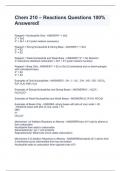
-
Chem 210 – Reactions Questions 100% Answered!
- Exam (elaborations) • 6 pages • 2024
- Available in package deal
-
- $13.99
- + learn more
Reagent = Nucleophile Only - ANSWER1° = Sn2 2° = Sn2 3° = Sn1 + E1 (polar medium necessary) Reagent = Strong Nucleophile & Strong Base - ANSWER1° = Sn2 2° = E2 3° = E2 Reagent = Weak Nucleophile and Weak Base - ANSWER1°/2° = No Reaction 3°/resonance stabilized carbocation = Sn1 + E1 (polar medium necessry Reagent = Base Only - ANSWER1° = E2 or Sn2 (if unhindered and no beta-hydrogen with unhindered base) 2° = E2 3° = E2 Examples of Only Nucleophiles - ANSWERCl⁻, ...
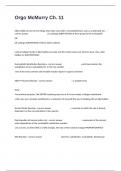
-
Orgo McMurry Ch. 11 Actual Questions And Answers Verified.
- Exam (elaborations) • 7 pages • 2024
-
Available in package deal
-
- $12.99
- + learn more
Alkyl halides do one of two things when they react with a nucleophile/base, such as a hydroxide ion... - correct answer (1) undergo SUBSTITUTION of the X group by the nucleophile OR (2) undergo ELIMINATION of HX to yield an alkene carbon-halogen bonds in alkyl halides are polar and the carbon atoms are electron-poor, thus, alkyl halides are ELECTROPHILES Nucleophilic Substitution Reactions - correct answer -each st...
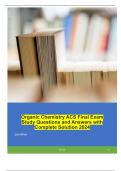
-
Organic Chemistry ACS Final Exam Study Questions and Answers with Complete Solution 2024
- Exam (elaborations) • 6 pages • 2024
-
Available in package deal
-
- $13.49
- + learn more
Basicity rules - -strong base: unstable/reactive (ED groups) -weak base: stable (EW groups/more EN/bigger) Chair conformation - -more stable equitorial (slanted) -pointing up/pointing down=cis if both up -elimination: trans and diaxial Newman projection - -gauche: substituent groups adjacent to eachother -grab middle and turn to put in plane Enantiomers - -not superimposable mirror images -same besides stereochemistry Diastereomers - -mirror images but one stereocenter stays and...
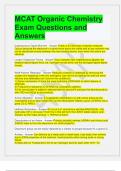
-
MCAT Organic Chemistry Exam Questions and Answers
- Exam (elaborations) • 20 pages • 2024
-
- $12.49
- + learn more
MCAT Organic Chemistry Exam Questions and Answers Instantaneous Dipole Moment - Answer-Exists in an otherwise nonpolar molecule. Occurs because the electrons in a bond move about the orbital and at any moment may not be distributed exactly between the two bonding atoms, even when the atoms are identical. London Dispersion Forces - Answer-Occur between two instantaneous dipoles; the weakest dipole-dipole force (vs. hydrogen bonds which are the strongest dipole-dipole forces). Wolff-Kishner...
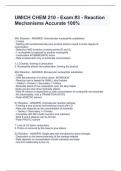
-
UMICH CHEM 210 - Exam #3 - Reaction Mechanisms Accurate 100%
- Exam (elaborations) • 3 pages • 2024
-
Available in package deal
-
- $10.49
- + learn more
SN1 Reaction - ANSWER- Unimolecular nucleophilic substitution - 2 steps - Starting with enantiomerically pure product tends to result in some degree of racemization - Retention AND inversion at stereocenter (R and S) - 1 nucleophile is replaced by another nucleophile - Carbocation INTERMEDIATE forms - Rate is dependent only on substrate concentration 1. LG leaves, forming a carbocation 2. Nucleophile attacks the carbocation, forming the product SN2 Reaction - ANSWER- Bimolecular nuc...
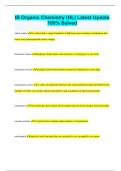
-
IB Organic Chemistry (HL) Latest Update 100% Solved
- Exam (elaborations) • 3 pages • 2024
-
Available in package deal
-
- $8.49
- + learn more
IB Organic Chemistry (HL) Latest Update 100% Solved chiral carbon A carbon that is singly bonded to 4 different atoms forming a tetrahedron that forms non-superimposable mirror images homolytic fission breaking a bond where each electron in a bond goes to one atom heterolytic fission breaking a bond where both electrons in a bond goes to one atom homologous series A series of molecules that have the same general formula but differ by the number of CH2's, has similar chemical ...
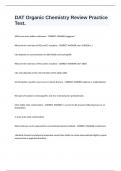
-
DAT Organic Chemistry Review Practice Test.
- Exam (elaborations) • 17 pages • 2024
-
- $12.99
- + learn more
DAT Organic Chemistry Review Practice Test. Which are more stable conformers - CORRECT ANSWER staggered What are the rate laws of SN2 and E2 reactions - CORRECT ANSWER rate= k [RX][Nu:-] rate depends on concentrations of alkyl halide and nucleophile What are the rate laws of SN1 and E1 reactions - CORRECT ANSWER rate= k[RX] rate only depends on the concentration of the alkyl halide E2 elimination reactions must occur in bonds that are - CORRECT ANSWER coplanar or antiperiplan...
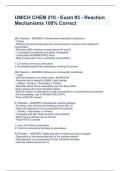
-
UMICH CHEM 210 - Exam #3 - Reaction Mechanisms 100% Correct
- Exam (elaborations) • 3 pages • 2024
-
Available in package deal
-
- $9.99
- + learn more
UMICH CHEM 210 - Exam #3 - Reaction Mechanisms 100% Correct SN1 Reaction - ANSWER- Unimolecular nucleophilic substitution - 2 steps - Starting with enantiomerically pure product tends to result in some degree of racemization - Retention AND inversion at stereocenter (R and S) - 1 nucleophile is replaced by another nucleophile - Carbocation INTERMEDIATE forms - Rate is dependent only on substrate concentration 1. LG leaves, forming a carbocation 2. Nucleophile attacks the carbocati...
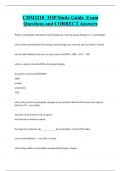
-
CHM2210 TOP Study Guide Exam Questions and CORRECT Answers
- Exam (elaborations) • 9 pages • 2024
-
- $7.99
- + learn more
What is nucleophilic substitution?replacing a leaving group (halogen) w/ a nucleophile what is beta-eliminationa halogen and hydrogen are removed and a pi bond is formed rate the alkyl halides from most to least reactiveRI > RBr > RCl >> RF what is a protic solventhas hydrogen bonding list aprotic solventsDMSO DMF acetone acetonitrile THF

How much did you already spend on Stuvia? Imagine there are plenty more of you out there paying for study notes, but this time YOU are the seller. Ka-ching! Discover all about earning on Stuvia


